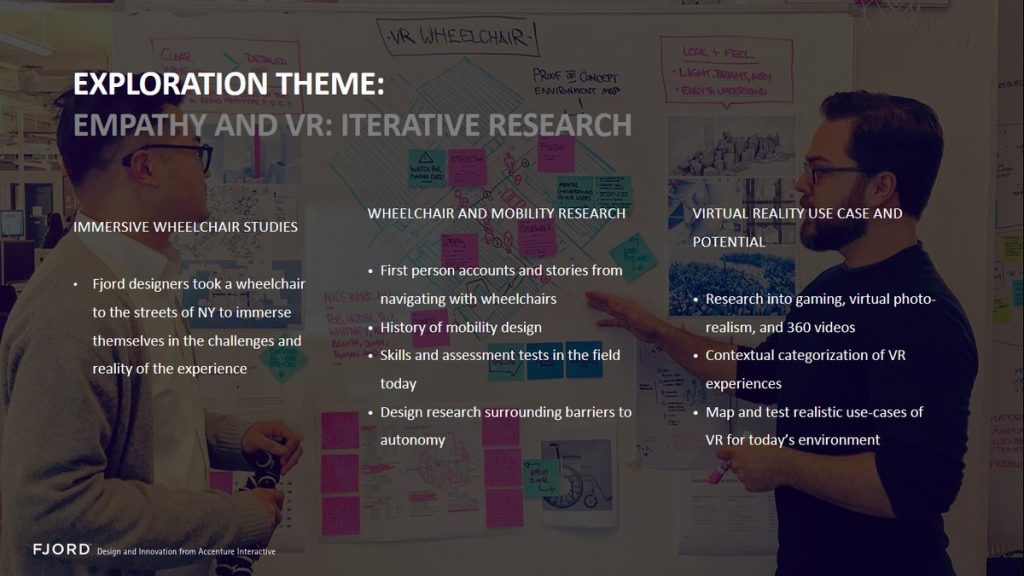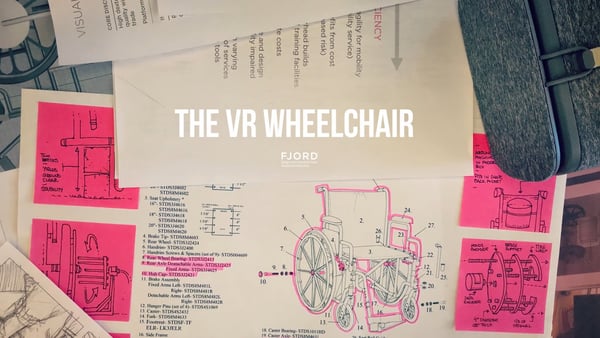Published · Updated
In recent years, many innovative companies have utilized the power of technology to make life a little bit easier for people who are wheelchair bound. One of these companies is Fjord, whose tagline is “Design and Innovation from Accenture Interactive.” Their recent Makeshop program discovered as way to use virtual reality and empathy to aid people understanding their new wheelchair. Fjord worked hard to make sure the virtual reality wheelchair experience was meaningful, and not trivialized or too game-like.
Their process produced a concept that gives newly wheelchair-bound individuals a truly immersive and empathetic learning experience. Fjord took inspiration from multiple other projects during their research period, especially ones like their own Wheelchair Fitness Tracker that enable wheelchair-bound people to participate in the popular fitness-tracking trend by using an app that tracks their wheel rotation, pushing effort and incline/decline of the chair.

For the virtual reality project, Fjord started with an interviewing process where they talked to people who used wheelchairs on a constant or regular basis. They picked up on some patterns and shared problems, and also uncovered the fact that many struggled greatly the first day they used a wheelchair. They also revealed challenges these people face in learning to understand how to navigate pedestrian paths and adapting to their new environment.
Some of the key difficulties they highlighted were the struggles wheelchair users face in dealing with concrete angles, curb heights, and so on. These are struggles that are especially prominent in city environments.

Following their in-depth research, they launched what they officially are calling the Wheelchair Training Program. Their approach is to make it sensitive and empathetic, and most of all, it will help new wheelchair users engage with their new, complex environment in a safe and supportive way. The proof of concept they developed focused on being compelling, respectful, immersive—and of course it had to be useful. Articulation of their steering, understanding spatial relationships, and navigating around obstacles were all common issues that Fjord picked up on during their dozens of interviews.
Using their acquired knowledge, they developed a virtual reality simulated environment using Unity 3D software. Rather than stressing over realistic 3D renderings, they focused on functional clarity in order to finish up the prototype more quickly. The world of their 3D model is bright, light, and airy, which allows users to focus more on the obstacles and intents of the program.
As of right now, Fjord is hard at work perfecting their program. They have continued their research and revision process, and they remain strong in their stance that virtual reality holds significant value for disabled people around the world.
Tags: #health #VR #wheelchair #digitalhealth #xmed #healthiAR #mobility #disability #disable #innovation
by kristi · Published December 16, 2016
by Milly Lammens · Published October 10, 2017 · Last modified October 12, 2017
by kristi · Published January 7, 2017 · Last modified January 19, 2017
More
Branded Experiences / Device/Demonstration / HTC Vive / Neurology / Oculus Rift
28 Oct, 2016
360° Video / Neurology / Oculus Rift / Surgery / Training
Surgical Theatre VR for Neurosurgery
25 Oct, 2016
What do you think?
You are the first to add a thought